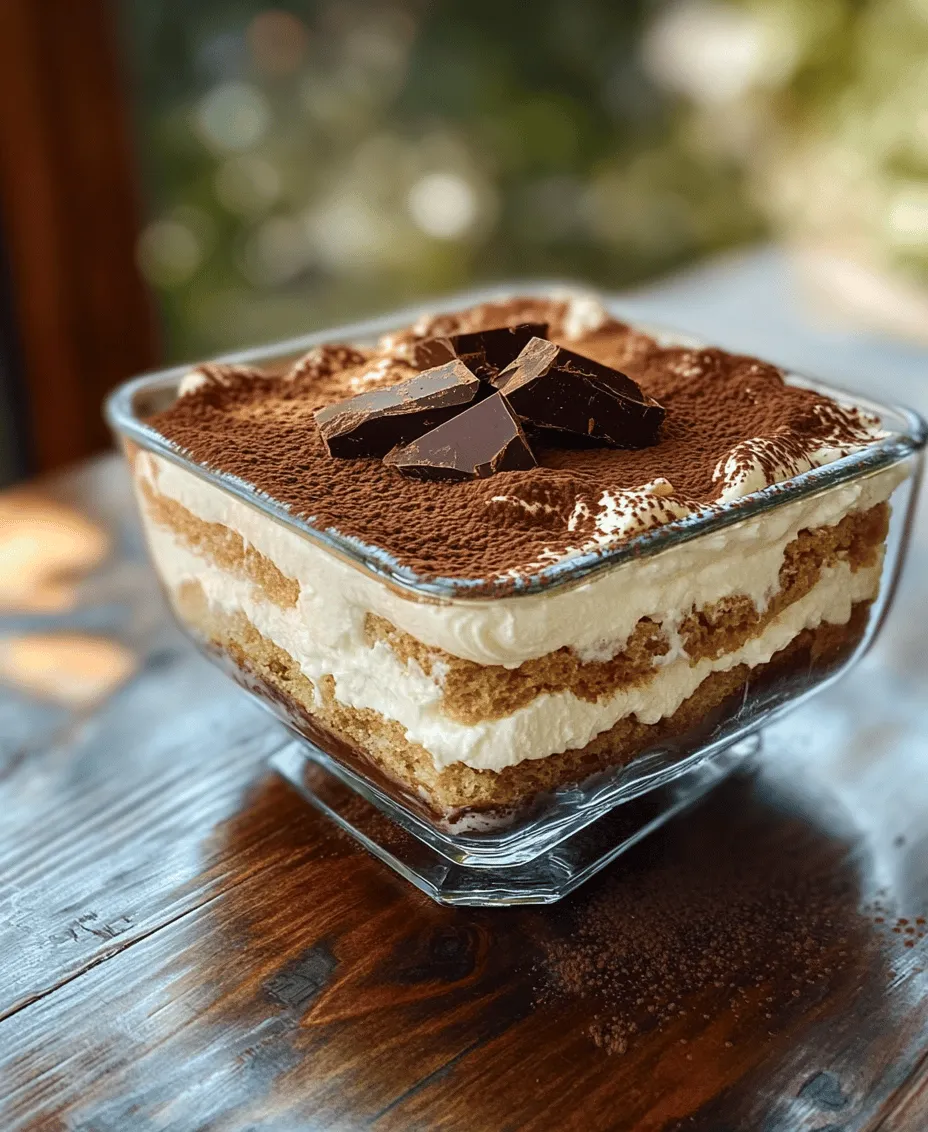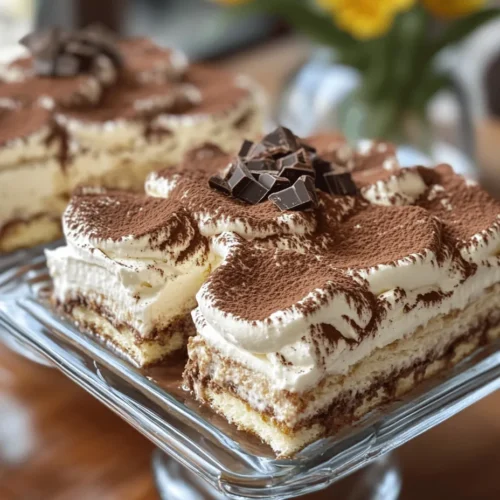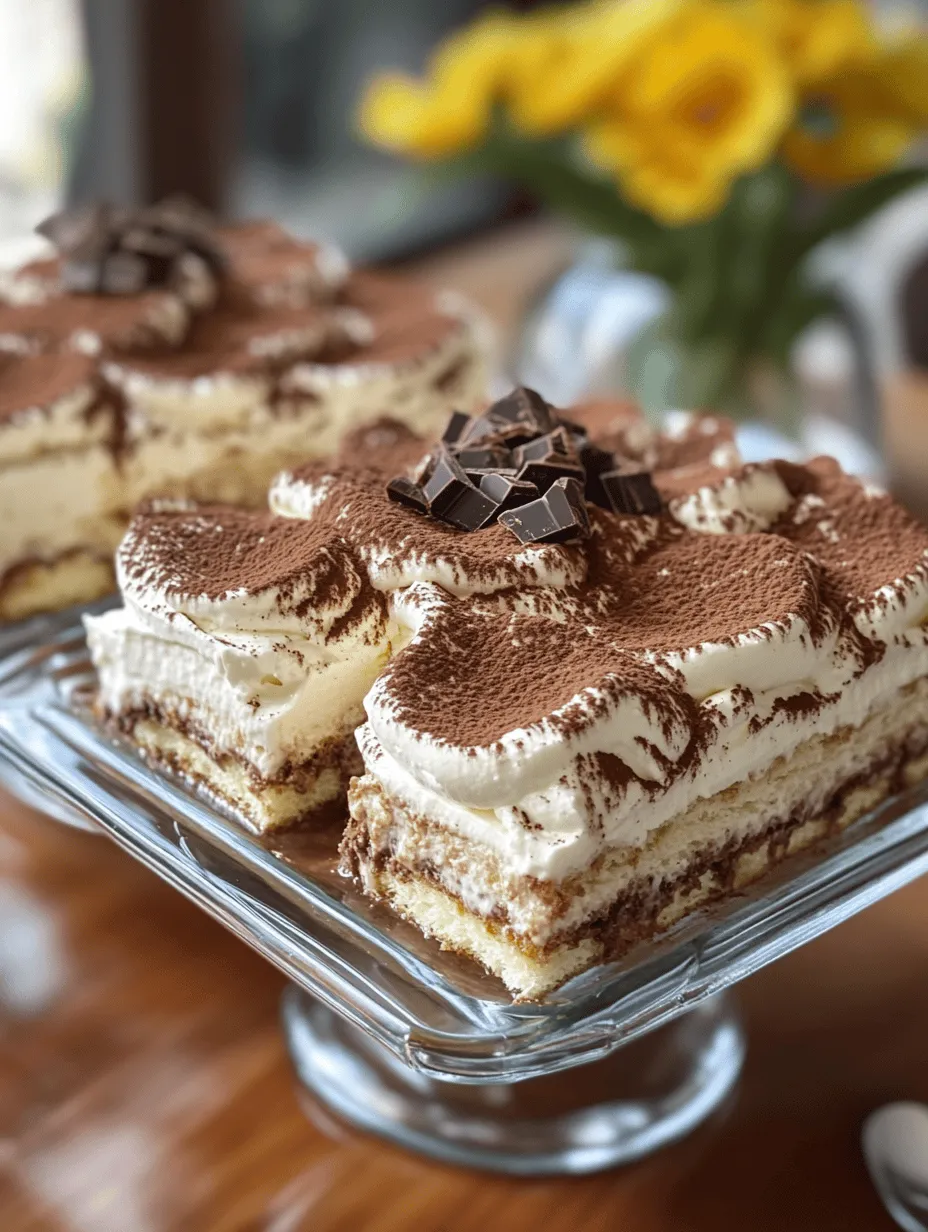Introduction
Delve into the world of Italian cuisine with our Classic Tiramisu Delight recipe. Tiramisu, which translates to “pick me up” in Italian, is a beloved dessert that captivates with its rich flavors and creamy texture. This indulgent treat combines layers of espresso-soaked ladyfingers with a luscious mascarpone mixture, creating a harmonious blend that is sure to satisfy any sweet tooth. Whether you’re entertaining guests or simply treating yourself, this recipe will guide you through the process of creating this classic dessert from scratch, offering insights into its origins, variations, and the best way to serve it.
The Allure of Tiramisu: A Brief History
Tiramisu’s origins can be traced back to the Veneto region of Italy, particularly in the city of Treviso, during the 1960s. While its exact inception is subject to debate, several stories highlight its creation as a dessert meant to invigorate those who enjoyed it. The combination of espresso and cocoa was not only delicious but was believed to provide a boost of energy. This cultural significance is what makes tiramisu a staple in Italian cuisine, transcending generations and evolving into a global favorite.
As time progressed, tiramisu has seen numerous adaptations, with regional variations emerging across Italy and beyond. For instance, some regions have embraced the use of different liqueurs or flavored syrups, while others have altered the type of coffee used. Despite these changes, the core components remain the same, preserving the essence of what makes tiramisu so appealing. As a dessert that celebrates both simplicity and sophistication, it’s no wonder that tiramisu has become synonymous with Italian hospitality.
Understanding the Key Ingredients
To create a classic tiramisu, it’s essential to understand the key ingredients that contribute to its irresistible flavor and texture. Each component plays a critical role in crafting this dessert, ensuring a delightful experience with every bite.
Brewed Espresso: The Heart of the Dessert
At the heart of tiramisu lies brewed espresso. This bold, rich coffee not only adds depth of flavor but also serves as the primary source of moisture for the ladyfingers. The choice of coffee is crucial; high-quality, freshly brewed espresso will yield the best results. Opt for a blend that is strong and flavorful, as this will enhance the overall taste of the dessert.
Mascarpone Cheese: A Creamy Staple
Mascarpone cheese is another fundamental ingredient that gives tiramisu its signature creamy texture. This Italian cream cheese is rich and smooth, providing a luxurious base for the dessert. When incorporating mascarpone into the recipe, it’s essential to use room temperature cheese to ensure a seamless blend with the other ingredients.
Heavy Cream: Adding Lightness and Texture
To achieve the fluffy consistency that tiramisu is known for, heavy cream is whipped and folded into the mascarpone mixture. This step lightens the overall texture, creating a delightful contrast to the dense layers of coffee-soaked ladyfingers. The whipped cream should be beaten until soft peaks form, allowing it to retain its structure when mixed with the mascarpone.
Ladyfinger Cookies: The Foundation of the Layers
Ladyfinger cookies, or savoiardi, are the foundation of tiramisu. These sponge-like biscuits have a light and airy texture, making them perfect for soaking up the espresso without becoming overly soggy. When choosing ladyfingers, ensure they are of good quality, as they should hold their shape while still absorbing flavors.
Granulated Sugar and Vanilla Extract: Sweetening and Flavoring the Mix
Granulated sugar is essential for balancing the bitterness of the espresso and enhancing the overall flavor profile of the dessert. Additionally, a splash of vanilla extract adds warmth and depth, making each layer even more inviting.
Cocoa Powder and Dark Chocolate Shavings: The Finishing Touches
Finally, the dessert is crowned with a dusting of cocoa powder, which adds a touch of bitterness that complements the sweetness. For an extra layer of indulgence, dark chocolate shavings can be added as a garnish. These finishing touches not only enhance the visual appeal of tiramisu but also enrich the flavor experience.
Step-by-Step Guide to Making Classic Tiramisu
Creating the perfect tiramisu may seem daunting, but with a detailed step-by-step guide, you’ll find that it’s an accessible and rewarding culinary project. Below, we’ll walk you through the initial steps of preparing this classic dessert, ensuring you have all the tools and knowledge needed to impress your friends and family.
Brewing the Perfect Espresso
The first step in crafting your Classic Tiramisu Delight is brewing the perfect espresso. This foundational element will infuse the dessert with its characteristic flavor.
– Tips for Selecting Coffee Beans: Choose high-quality coffee beans that are freshly roasted. Look for espresso blends that are rich and bold, offering a strong flavor profile. If you prefer a slightly sweeter taste, consider blends with chocolate or nutty undertones.
– Methods for Brewing Espresso at Home: If you have an espresso machine, follow the manufacturer’s instructions for brewing. For those without an espresso machine, a Moka pot or AeroPress can yield excellent results as well. Aim for about 1 ½ cups of brewed espresso, which will be used for soaking the ladyfingers.
Preparing the Mascarpone Mixture
Once your espresso is brewed and cooled, it’s time to prepare the mascarpone mixture, which forms the creamy center of your tiramisu.
– Ensuring the Right Consistency: In a large mixing bowl, combine the mascarpone cheese with granulated sugar and vanilla extract. Use a spatula or a whisk to blend these ingredients gently, ensuring that the mascarpone remains smooth and creamy. The goal is to avoid overmixing, which can lead to a grainy texture.
– Incorporating Flavors Seamlessly: Next, in a separate bowl, whip the heavy cream until it reaches soft peaks. Gently fold the whipped cream into the mascarpone mixture using a spatula. Start by adding a small amount of whipped cream to lighten the mascarpone and then gradually fold in the rest. This technique preserves the airy texture of the whipped cream while ensuring it blends evenly with the cheese.
Following these initial steps will set you on the right path to creating a delightful Classic Tiramisu Delight. Stay tuned for the next part, where we will explore the assembly of the tiramisu, the layering process, and some helpful tips to ensure your dessert turns out perfectly every time.

Whipping the Heavy Cream
To achieve the light and airy texture that is characteristic of a classic tiramisu, whipping the heavy cream properly is essential. Start with a chilled mixing bowl and beaters, as cold tools help the cream whip more efficiently. Pour in 1 cup of heavy cream into the bowl. Begin beating on medium speed, gradually increasing to high as the cream starts to thicken.
Techniques for Achieving Stiff Peaks
The goal is to achieve stiff peaks, which means the cream should hold its shape without drooping. This usually takes about 3 to 5 minutes of mixing. Be cautious not to over-whip; if the cream becomes grainy or starts turning into butter, you have gone too far. An easy way to check for stiff peaks is to lift the beaters out of the cream—if the peaks stand straight up without collapsing, you have achieved the perfect consistency.
Importance of Gentle Folding
Once your cream is whipped to perfection, it’s crucial to incorporate it into the mascarpone mixture with care. Use a rubber spatula to gently fold the whipped cream into the mascarpone mixture. This technique preserves the airiness of the whipped cream, which is essential for achieving that melt-in-your-mouth texture that tiramisu is known for. Folding should be done in thirds; adding a third of the whipped cream first will lighten the mascarpone mixture, making it easier to fold in the rest without losing volume.
Dipping the Ladyfingers
Next up is the iconic element of tiramisu: the ladyfingers. The way you dip these cookies plays a significant role in the final texture of your dessert.
Timing and Technique for Optimal Texture
Prepare a shallow dish with your coffee mixture (made from freshly brewed espresso and a splash of liqueur if desired). The ladyfingers should be dipped swiftly—about 1 to 2 seconds per side is ideal. The goal is to soak them just enough to infuse flavor without making them mushy. If you leave them in the coffee mixture for too long, they will become overly soggy, impacting the structural integrity of your tiramisu.
How to Avoid Sogginess
To prevent sogginess, work quickly and avoid submerging the ladyfingers completely. A quick dip will allow the cookies to absorb just the right amount of liquid, ensuring they remain firm yet flavorful. If you prefer a less intense coffee flavor, consider diluting the coffee mixture slightly with water or milk.
Layering the Dessert
Now that your whipped cream and ladyfingers are prepared, it’s time to assemble the tiramisu.
Tips for Even Layering
Begin by spreading a thin layer of the mascarpone mixture in your serving dish. Place the first layer of dipped ladyfingers on top, ensuring they are arranged neatly and closely together. Spoon another layer of the mascarpone mixture over the ladyfingers, smoothing it out evenly. Repeat this process until you have three layers of ladyfingers and mascarpone mixture, finishing with a layer of the mascarpone on top.
Visual Appeal of the Final Product
For a stunning presentation, ensure your top layer is smooth and even. You can use a spatula to create a slight swirl on the surface. This will add a professional touch to your dessert. The visual appeal of tiramisu is often enhanced by a dusting of cocoa powder, which we’ll cover in the serving section.
Chilling Time: The Importance of Patience
Once your tiramisu is assembled, it’s time for the most challenging part: waiting.
Understanding Why Chilling is Crucial
Chilling is an essential step in the tiramisu-making process. It allows the flavors to meld together beautifully while the ladyfingers soften to create that signature creamy texture. Without adequate chilling, your tiramisu may not hold its shape when served.
Effects of Chilling on Flavor and Texture
The chilling process not only enhances the flavors but also allows the mascarpone to set properly. Ideally, you should refrigerate the assembled tiramisu for at least 4 to 6 hours, although overnight is even better. The longer it chills, the more the flavors will develop and the texture will improve.
Suggested Chilling Times for Best Results
For optimal results, aim to chill your tiramisu for at least 8 hours. If time permits, preparing it a day in advance is an excellent way to ensure your dessert is ready to impress at your next gathering.
Serving Your Classic Tiramisu
When it’s finally time to serve your classic tiramisu, presentation is key to making a lasting impression.
Presentation Tips to Impress Your Guests
To serve, cut the tiramisu into squares or rectangles, using a sharp knife to ensure clean edges. Place each serving on a dessert plate for an elegant touch.
Dusting with Cocoa Powder: Techniques for a Professional Finish
For that final flourish, dust the top layer with unsweetened cocoa powder. Use a fine mesh sieve to achieve an even dusting, ensuring you cover the surface without clumping. This not only adds a beautiful contrast but also enhances the flavor profile with a hint of bitterness that balances the sweetness of the mascarpone.
Adding Garnishes: Dark Chocolate Shavings and More
Consider adding garnishes to elevate your dessert. Dark chocolate shavings, chocolate curls, or even fresh berries can add a pop of color and an extra layer of flavor. A sprig of mint can also provide a refreshing contrast to the rich flavors of the tiramisu.
Serving Suggestions: Ideal Pairings with Coffee or Dessert Wines
Tiramisu pairs wonderfully with a cup of freshly brewed coffee or espresso, enhancing the coffee notes of the dessert. If you’d like to serve it alongside a beverage, consider a dessert wine such as Vin Santo or a sweet Marsala for a delightful finish.
Variations on the Classic Tiramisu Recipe
While the traditional tiramisu is beloved, there are numerous ways to put a creative twist on this classic dessert.
Exploring Creative Twists on the Traditional Recipe
– Flavor Infusions: Instead of using coffee, consider experimenting with other flavors. Matcha powder can create a vibrant green tiramisu, while chai spices can infuse warmth and depth. You can also use flavored liqueurs, such as Frangelico or Amaretto, to enhance the flavor profile.
– Dietary Adaptations: For those who follow a vegan or gluten-free diet, there are alternatives available. Vegan mascarpone can be made with cashews, and gluten-free ladyfingers are now widely available in stores or can be homemade.
– Seasonal Variations: Consider incorporating seasonal fruits or spices. A berry tiramisu can be made with layers of fresh strawberries or raspberries, while a pumpkin spice tiramisu is perfect for autumn gatherings.
Conclusion
Classic Tiramisu Delight is more than just a dessert; it is an experience that brings joy to gatherings and celebrations. With its rich history and delightful flavors, this recipe allows anyone to recreate a piece of Italy in their own kitchen. By following the step-by-step guide, you’ll be able to craft a beautiful tiramisu that will impress family and friends alike. Embrace the art of this classic dessert and enjoy the satisfaction of sharing a homemade treat that is sure to be a hit at any occasion. Whether you stick to the traditional recipe or explore creative variations, the love and care you put into making this dessert will be evident in every delicious bite.



